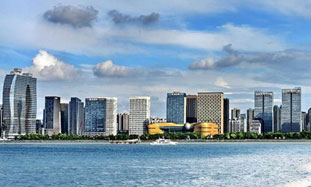Cultural relics tell story of civilization

Dealers at the recently opened China Hengdian Cultural Relics Market in Dongyang, Zhejiang province. [Photo provided to China Daily]
For Xu Wenrong, 85, founder of Hengdian World Studios, the nation's rich cultural relics are not only the "living fossils" of Chinese civilization, but also the symbols of exchange between civilizations.
The China Hengdian Cultural Relics Market, which opened at Hengdian World Studios, China's largest film and television production site dubbed as "China's Hollywood", in Dongyang, Zhejiang province, on Nov 13, showcases cultural relics and artworks that tell the story of Chinese civilization. This is a new adventure for Xu after he launched the massive Hengdian World Studios in 1996.
The market mainly engages in display, trading, auctioning, appraisal, evaluation and customization of cultural relics, artworks and tourism commodities. In addition, it offers high-level forums, cultural creativity, sightseeing tourism and participatory experiences.
The first phase of the market has more than 300 booths, each with a floor space of 48 square meters and featuring jadeware, porcelain, calligraphy and paintings.
"Collecting folk artifacts here is conducive to inheriting Chinese culture and enriches the spiritual life of people in Hengdian," said Xu, adding that, by unleashing the huge market potential of the cultural and museology collection industry, it will enable cultural relics and artworks to enter the homes of ordinary people.
A primary school dropout who later became a legendary entrepreneur, Xu founded the Hengdian Group and launched the Hengdian World Studios in Dongyang, Zhejiang in the 1990s.
The company formed a relationship with the film and TV industry by chance when director Xie Jin called for the building of sets for the film The Opium War in 1996.With Xu's approval and support, Hengdian Group created a 19th-century Guangzhou street in just over four months, which later developed into the world's largest film studio.

 Print
Print Mail
Mail
 20 Cultural Symbols
20 Cultural Symbols Why Zhejiang
Why Zhejiang Experiencing high-tech products at WIC
Experiencing high-tech products at WIC Zhejiang Release
Zhejiang Release Zhejiang News
Zhejiang News